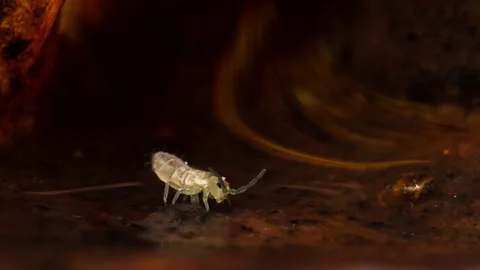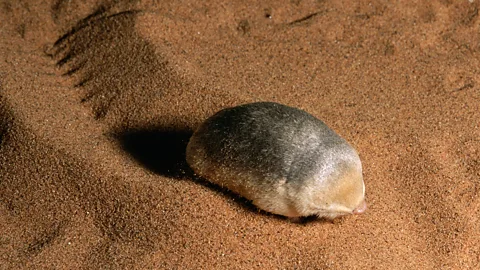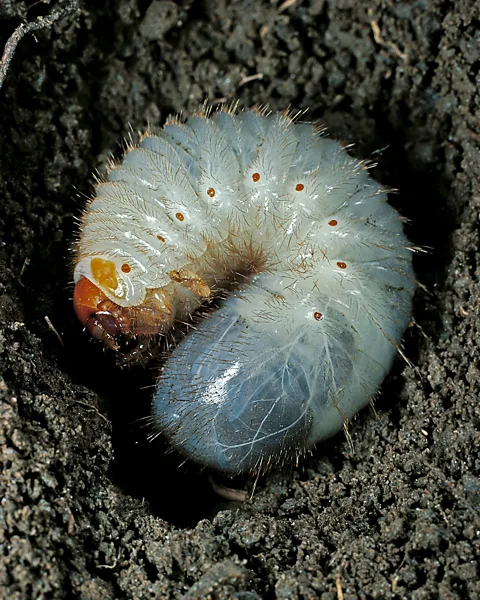Why soil is a surprisingly noisy place
 Getty Images
Getty ImagesThe worms, grubs and roots rummaging unseen beneath our feet produce a cacophony of sounds that we are only just starting to listen to in an attempt to understand more about life underground.
The first time that Marcus Maeder stuck a noise sensor into the ground, it was on a whim. A sound artist and acoustic ecologist, he was sitting in a mountain meadow and pushed a special microphone he'd built into the soil. "I was just curious," says Maeder, who is working on a dissertation on the sounds of biodiversity at the Swiss Federal Institute of Technology in Zürich, Switzerland.
He certainly wasn't prepared for the clamour of sounds that flooded his headset. "They were very strange," he says. "There was thrumming and chirring and scraping. You need a whole new vocabulary to describe it."
Maeder was eavesdropping, he realised, on creatures that live in the soil.
Ecologists have long known that the ground beneath our feet is home to more life, and more diverse life, than almost any other place on Earth. To a layperson, soil seems little more than a compact layer of dirt. But in fact, the ground is a labyrinthine landscape of tunnels, cavities, roots and decaying litter.
In just a cup of dirt, researchers have counted up to 100 million life forms, from more than 5,000 taxa. Underground denizens range from microscopic bacteria and fungi, pencil-dot-sized springtails and mites, to centipedes, slugs and earthworms that can reach several metres in length. They are joined by moles, mice and rabbits that live at least some of their lives in underground tunnels and dens.
"It's a staggering amount of biodiversity," says Uffe Nielsen, a soil biologist at Western Sydney University in Australia. It's also a vital one – collectively, these subterranean communities form much of the basis for life on our planet, from the food we eat to the air we breathe.
Today, in a relatively new field known as soil bioacoustics – others prefer terms such as biotremology or soil ecoacoustics – a growing number of biologists are capturing underground noises to open a window into this complex and cryptic world. They've found that something as simple as a metal nail pushed into the dirt can become a sort of upside-down antenna if equipped with the right sensors. And the more researchers listen, the more it becomes apparent how much the ground below us is thrumming with life.
 Paul Cooper/Getty Images
Paul Cooper/Getty ImagesEavesdropping on this cacophony of underground sounds promises to reveal not only what life forms reside below our feet but also how they go about their existence – how they eat or hunt, how they slither past each other unnoticed, or drum, tap and sing to get one another's attention. Life underground "is a black box", says Nielsen. "As we open it, we realise how little we know."
Understanding this underground life is important because soil ecology is crucial. "Soil helps to transform the nutrient elements like carbon, nitrogen, phosphorus and potassium that feed plants – for food, for forests, or to fill the air with oxygen, so we can all breathe," says Steven Banwart, a soil, agriculture and water researcher at the University of Leeds in the UK, who co-wrote an overview of the functions of soil in the Annual Review of Earth and Planetary Sciences. Worms, grubs, fungi, bacteria and other decomposers are involved in every step.
And every soil organism produces its own soundtrack. Root-munching larvae emit short clicks as they break the fibres of their meal. Worms rustle as they crawl through tunnels. So do plant roots as they push past grains of soils, as Swiss researchers reported in 2018. But the roots move slower than the worms do, and at a steadier pace. By distinguishing these sounds, soil acoustics stands to shed light on some hitherto unanswerable questions. Like, when do plant roots grow? At night? During the day? Only when it rains?
You might also like:
We humans might be among the last to discover this underground soundtrack. Birds can often be seen hopping across lawns with their heads cocked. Researchers believe that they do this because they're listening for worms or larvae below. Often, they peck at the soil at just the right moment to pull up their unsuspecting quarry.
The North American wood turtle, for its part, capitalises on the attention that worms pay to vibrations from the patter of rain. The turtle stomps its feet on the ground to mimic that patter so the worms come to the surface, providing a juicy snack.
 Minden Pictures/Alamy
Minden Pictures/AlamySubterranean vibrations can also be key for what appear to be intended signals. Mole rats, living in underground burrows, are thought to communicate with other mole rats in the vicinity by banging their heads or feet against the walls of their tunnels. Leafcutter ants have been observed to create noises when they get buried during nest cave-ins. Other worker ants rush to the spot and start to dig to rescue their nestmate.
Some of these underground sounds are audible to the human ear, but many are too high or too low in frequency (as well as in volume). To capture these, researchers use tools like piezoelectric sensors, which work like the contact microphones you might clip onto a guitar. Attached to a nail, sometimes up to 30cm (11.8 inches) long, that has been pushed into the ground, these sensors detect vibrations that researchers then convert into electronic signals and amplify until humans can hear them.
Carolyn-Monika Görres, a landscape ecologist at Geisenheim University in Germany, was among those shocked to discover how much underground noise can reveal. Görres studies root-feeding beetle larvae known as white grubs – she's specifically interested in the gases, such as methane, that they emit. Biologists suspect that these small insects, of varying species, contribute substantial amounts of climate emissions, due to their sheer numbers. (Termites, for example, are estimated to produce about 1.5% of global methane emissions. For comparison, the amount from coal mining is 5-6%.)
Early on, Görres was stumped. How would she know how many of these inch-long larvae were living in a patch of soil? "Traditionally, you dig up the ground to see what's there," she says. "But then, everything is disturbed."
So Görres biked to meadows and forests around her town and buried two dozen acoustic sensors in the soil and recorded the larvae going about their business. When she plays the recordings to other people, "some say it sounds like the creaking of a tree", she says. "Others hear pieces of sandpaper being rubbed together."
Görres has learned that she can distinguish between the larvae of the two white grub species she studies – the common cockchafer (Melolontha melolontha) and the forest cockchafer (M. hippocastani) by virtue of a buzzing that's similar to the aboveground singing, or stridulation, of cicadas and grasshoppers.
The larvae do this by rubbing their mandibles together. "One could say they grind their teeth to talk to each other underground," Görres says. "The beauty about stridulations is that they seem to be species-specific, just like bird songs."
Once the larvae pupate, they switch to another noisemaking mechanism, rotating their abdomen within their shell and banging it against the shell wall.
What are they doing it for? That isn't clear. Above ground, insect stridulation attracts mates. But for larvae, "reproduction doesn't matter yet", Görres says. To learn more, the ecologist (who has dubbed her soil acoustic project "Underground Twitter") filled containers with sandy soil from the insects' natural habitat, added slices of carrots to keep the grubs happy, and took them to her lab.
She noticed that a larva kept on its own rarely stridulated. But if more than one shared a container, they sang – a lot. A trio of cockchafer larvae stridulated a total of 682 times during their first two-and-a-half hours together.
 Paul Starosta/Getty Images
Paul Starosta/Getty ImagesGörres suspects that the grubs sing to warn each other away. Larvae are consummate feeders – "their one purpose in life is to gain biomass," she says – and if too many share the same bit of soil, they start cannibalising each other. In support of this, she notes that scientists have spotted larvae changing course to avoid abdomen-banging pupae.
When we talk about sound, we mostly refer to pressure waves that travel through the air. As they hit our ears, they vibrate the eardrums, and our brains ultimately translate these oscillations into sounds.
But these waves can also travel through other media, like water or soil. Elephants know this well – they vocalise a low-frequency rumble that propagates through the ground, enabling them to keep in touch with far-flung brethren who pick up the signals with the soles of their feet.
Acoustic emissions can also travel through different media simultaneously. Male mole crickets (Gryllotalpa major) dig horn-like burrows into sandy soil, from which they stridulate by rubbing their wings together. The chirping aims to court females that are flying in the air. But it also travels as vibrations through the soil where it may warn off other male crickets in their own subterranean burrows.
Some animals have adapted their ears to better catch such substrate-borne vibrations. In the Namib Desert lives a golden mole, a small, furry mammal that is nocturnal and mostly blind. At night, the mole hunts for termites in the dunes by "swimming" through the sand with its head and shoulders submerged. Biologists think that it does so to listen for prey. One of the ossicles, or bones, in the mole's middle ear is massively enlarged. Researchers believe that this helps the animal to pick up ground-borne vibrations in a process that's similar to what happens with air-borne sound waves in human ears.
Snakes, on the other hand, receive vibrational signals through sensors in their jaws. The star-nosed mole sports a strange, tentacled nose that can pick up vibrations. And many insects have mechanosensors in their legs that register pulsing in the ground.
It makes perfect sense that underground animals incorporate sound into their lives, says Matthias Rillig, a soil ecologist at the Free University of Berlin. "Sound is a high-speed signal that comes at little extra cost," he says – certainly less than producing chemicals like pheromones for communication. Sound also tends to travel faster and farther than chemical signals. The rumble of an elephant can propagate for miles. Vibrations initiated by a small underground insect may only reach a few dozen centimetres, but in a world where much is measured in micrometres, that's still a long distance.
Do life forms other than animals sense these underground vibrations and make use of them? Rillig has begun a project in which he and Maeder bring tiny soil critters like springtails and soil mites into the lab and record them for hours to test how much noise they make, either alone or grouped with other species. The ecologist wonders if fungi might be able to register sounds coming from these micropredators and stay away from areas where they congregate, since some of them like to eat fungal filaments.
"Or a fungus could respond to sound cues of danger by increasing sporulation," says Rillig. This would help ensure that its genes get dispersed before it gets eaten.
There is already some evidence that plants, at least, make use of sound to help their survival. In tests, evolutionary ecologist Monica Gagliano offered garden pea plants (Pisum sativum) the option to grow their roots down different plastic tubes. All the tubes were filled with soil, but some were exposed to the vibrations of flowing water (running through a tube on the outside of the pipe). Gagliano, of the Biological Intelligence Lab at Southern Cross University, the University of Western Australia and the University of Sydney, reported that the pea plants favoured growing roots toward the sound of water, even though the water itself was not accessible to the plants and no moisture could seep into the tubes.
 Alamy
AlamyBesides informing ecologists, underground acoustics could help us take better care of the environment and detect pests that cause billions of dollars in damage every year. As far back as 1478, "pasture scarabs were causing significant damage to Swiss Alpine meadows to such an extent that the Bishop of Lausanne excommunicated the offending herbivores", scientists wrote in a 2015 review paper on root-feeding insects. (To name one current example, infestations of the grape root borer Vitacea polistiformis can decrease a grapevine's yield as much as 47%.)
Without a way to pinpoint infestations, ground managers commonly have to resort to fighting pests like these with blanket pesticide applications, says Louise Roberts, a bioacoustician at Cornell University. "But that kills all sorts of things underground." Often, it would be enough to treat just parts of a field or golf course, since soil insects tend to cluster. "But for that to work, you need to know where the pests are," she says.
And so Roberts and her colleagues have been conducting a study to see if ground managers can push sensors into turf grass and use the frequencies of collected sounds to pinpoint subterranean pest infestations and to identify the species. The work isn't done, but early results suggest it is possible, she says.
To their dismay, researchers are discovering that not everything they detect underground is exotic and new. Some noises are disturbingly familiar. When Maeder listens underground in his home country of Switzerland, "I can hear construction sites and highways that are far away. Even airplanes."
It's still unclear what impact human sound pollution has on subterranean life. "It's hard to believe it wouldn't have any," says Rillig.
Scientists are also finding that the underground orchestra of animal activity has started to fall silent in large tracts of land, particularly in intensely farmed fields, where "things go quiet", says Maeder.
A lessening of noises hints at diminished biodiversity and thus a less healthy soil. That dovetails with a recent report by the Food and Agriculture Organization finding that a third of the world's land has been at least moderately degraded, often through agriculture.
Maybe soil acoustics will help more people realize what we're in danger of losing, Maeder says. He has started a citizen science project that lends people in Switzerland acoustic sensors to listen for underground activity themselves. The recordings are being assembled into a national library of soil sounds with the hope of raising awareness.
Demand so far is high, Maeder says. "The sensors are always booked."
* This article originally appeared in Knowable Magazine, and is republished under a Creative Commons licence.
--
